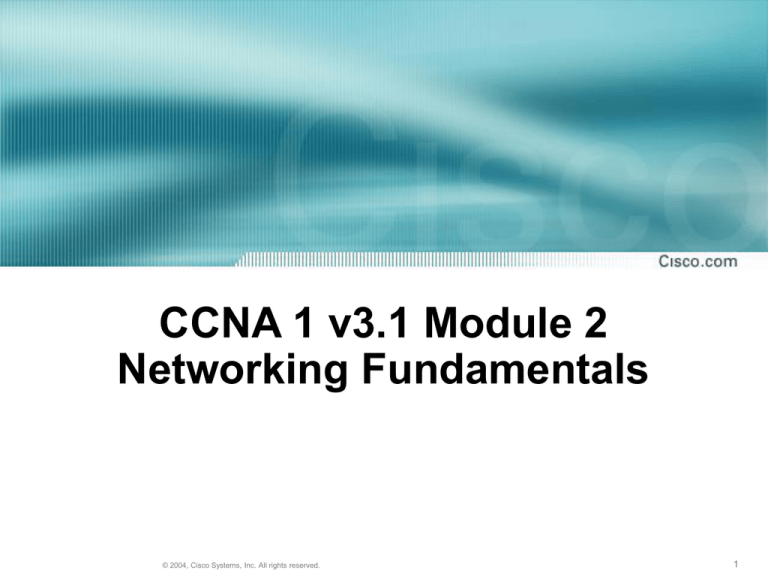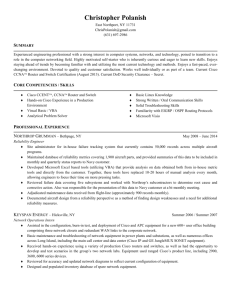
CCNA 1 v3.1 Module 2
Networking Fundamentals
© 2004, Cisco Systems, Inc. All rights reserved.
1
Purpose of This PowerPoint
• This PowerPoint primarily consists of the Target
Indicators (TIs) of this module in CCNA version
3.1.
• It was created to give instructors a PowerPoint to
take and modify as their own.
• This PowerPoint is:
NOT a study guide for the module final assessment.
NOT a study guide for the CCNA certification exam.
• Please report any mistakes you find in this
PowerPoint by using the Academy Connection
Help link.
© 2004, Cisco Systems, Inc. All rights reserved.
2
To Locate Instructional Resource Materials
on Academy Connection:
• Go to the Community FTP Center to locate
materials created by the instructor community
• Go to the Tools section
• Go to the Alpha Preview section
• Go to the Community link under Resources
• See the resources available on the Class home
page for classes you are offering
• Search http://www.cisco.com
• Contact your parent academy!
© 2004, Cisco Systems, Inc. All rights reserved.
3
Objectives
© 2004, Cisco Systems, Inc. All rights reserved.
4
Data Networks
© 2004, Cisco Systems, Inc. All rights reserved.
5
Network History
© 2004, Cisco Systems, Inc. All rights reserved.
6
Network History continued
© 2004, Cisco Systems, Inc. All rights reserved.
7
Networking Devices
© 2004, Cisco Systems, Inc. All rights reserved.
8
Network Topology
© 2004, Cisco Systems, Inc. All rights reserved.
9
Network Protocols
© 2004, Cisco Systems, Inc. All rights reserved.
10
Local-area Networks (LANs)
© 2004, Cisco Systems, Inc. All rights reserved.
11
Wide-area Networks (WANs)
© 2004, Cisco Systems, Inc. All rights reserved.
12
Metropolitan-Area Network (MANs)
© 2004, Cisco Systems, Inc. All rights reserved.
13
Storage-Area Networks (SANS)
© 2004, Cisco Systems, Inc. All rights reserved.
14
Virtual Private Networks (VPNs)
© 2004, Cisco Systems, Inc. All rights reserved.
15
Benefits of VPNs
© 2004, Cisco Systems, Inc. All rights reserved.
16
Intranet and Extranet VPN
© 2004, Cisco Systems, Inc. All rights reserved.
17
Importance of Bandwidth
© 2004, Cisco Systems, Inc. All rights reserved.
18
Bandwidth Pipe Analogy
© 2004, Cisco Systems, Inc. All rights reserved.
19
Bandwidth Highway Analogy
© 2004, Cisco Systems, Inc. All rights reserved.
20
Bandwidth Measurements
© 2004, Cisco Systems, Inc. All rights reserved.
21
Bandwidth Limitations
© 2004, Cisco Systems, Inc. All rights reserved.
22
Bandwidth Throughput
© 2004, Cisco Systems, Inc. All rights reserved.
23
Digital Transfer Calculation
© 2004, Cisco Systems, Inc. All rights reserved.
24
Digital versus Analog
© 2004, Cisco Systems, Inc. All rights reserved.
25
Using Layers to Analyze Problems
© 2004, Cisco Systems, Inc. All rights reserved.
26
Using Layers to Describe Data Communication
© 2004, Cisco Systems, Inc. All rights reserved.
27
OSI Model
© 2004, Cisco Systems, Inc. All rights reserved.
28
OSI Layers
© 2004, Cisco Systems, Inc. All rights reserved.
29
OSI Layers
•Provides connectivity and path selection between two host
•Provides Logical address
•No error correction, best effort delivery.
© 2004, Cisco Systems, Inc. All rights reserved.
30
OSI Layers
© 2004, Cisco Systems, Inc. All rights reserved.
31
OSI Layers
© 2004, Cisco Systems, Inc. All rights reserved.
32
OSI Layers
© 2004, Cisco Systems, Inc. All rights reserved.
33
OSI Layers
© 2004, Cisco Systems, Inc. All rights reserved.
34
OSI Layers
© 2004, Cisco Systems, Inc. All rights reserved.
35
Peer-to-Peer Communication
© 2004, Cisco Systems, Inc. All rights reserved.
36
TCP/IP Model
© 2004, Cisco Systems, Inc. All rights reserved.
37
Encapsulation
© 2004, Cisco Systems, Inc. All rights reserved.
38
Names for Data at Each Layer
© 2004, Cisco Systems, Inc. All rights reserved.
39
Summary
© 2004, Cisco Systems, Inc. All rights reserved.
40




